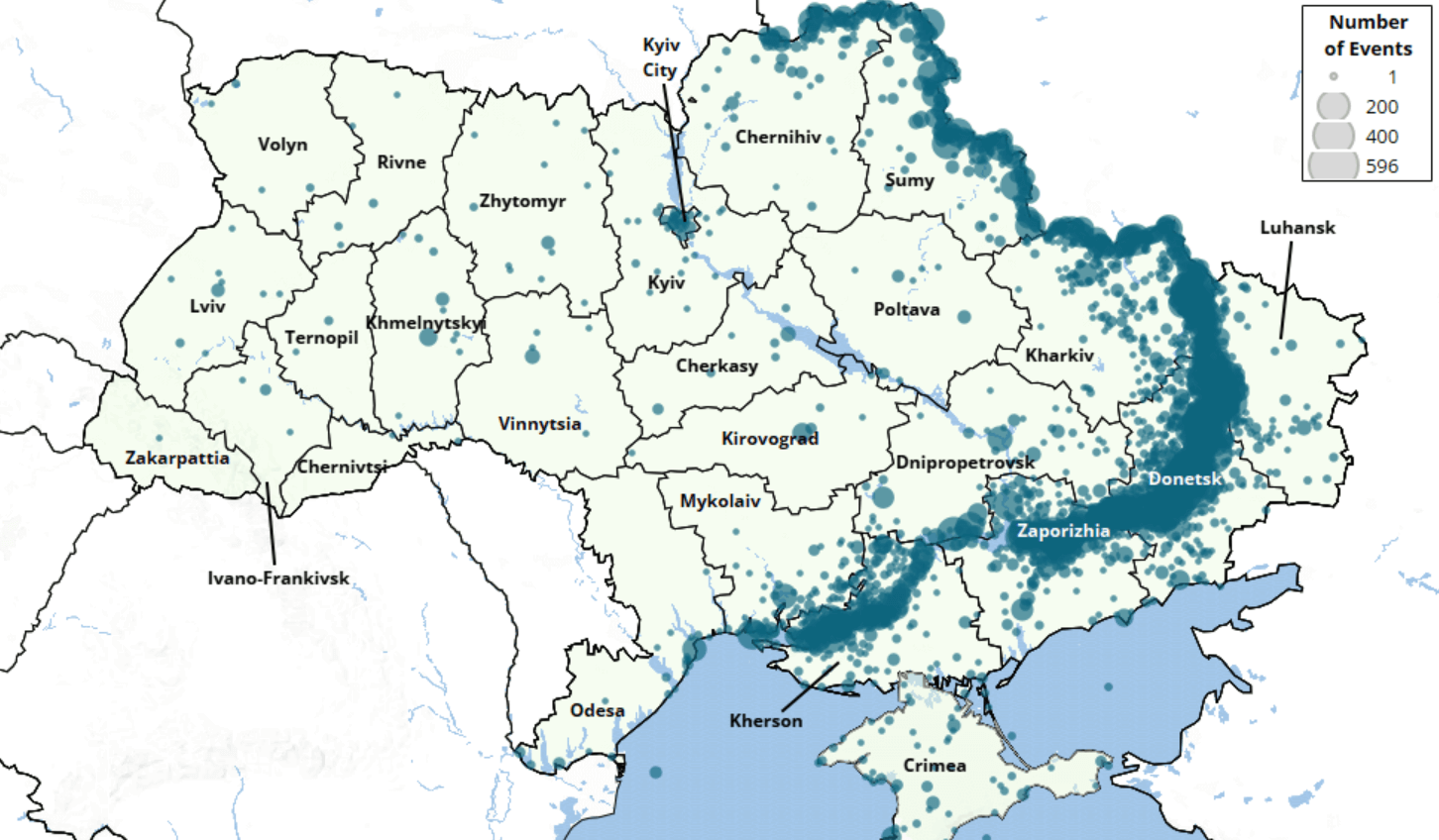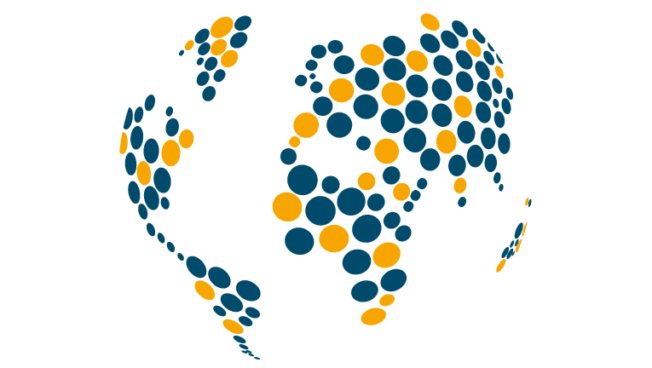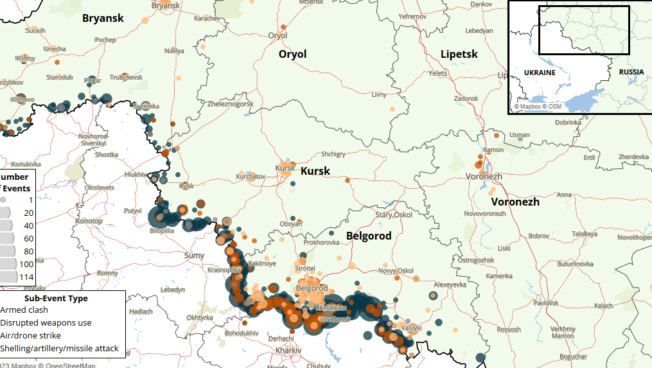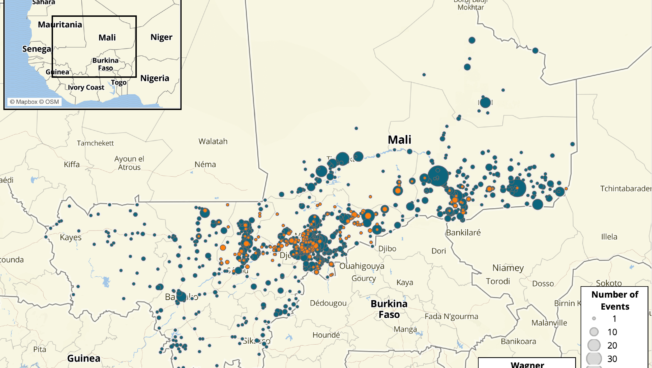ACLED’s Ukraine Conflict Monitor provides near real-time information on the ongoing war, including an interactive map of the latest data from the start of Russia’s invasion, a curated data file, and weekly situation updates. It is designed to help researchers, policymakers, media, and the wider public track key conflict developments in Ukraine. It is released every Wednesday, with data covering events from Saturday to Friday of the preceding week and providing updates to past events as new or better information becomes available.
Due to the methodological limitations of event-based data collection, in addition to the broader challenges around fatality reporting in fast-moving conflict contexts like Ukraine, fatality estimates in the ACLED dataset pertain specifically to those fatalities reported in connection with distinct events that meet ACLED’s catchment and minimum threshold for inclusion (i.e. date, location, and actor information). This means that aggregate tallies provided by sources such as hospitals and government agencies, for example, which cannot be broken down and connected to individual conflict incidents, are not included in the ACLED dataset. ACLED fatality numbers are conservative event-based estimates, and the full death toll in such contexts is likely higher than the number of reported fatalities currently attributed to the type of distinct incidents that can be captured in the dataset. For these reasons, the Monitor will not be providing regular fatality estimate updates at this time.1Tracking fatalities is one of the most difficult aspects of conflict data collection in general, as fatality counts are frequently the most biased, inconsistent, and poorly documented components of conflict reporting, and this is especially true of active conflict environments impacted by high levels of mis/disinformation and severe access constraints. ACLED defaults to conservative estimates based on the best available information at the time of coding in line with our specific event-based methodology and review process. ACLED estimates are restricted to fatalities reported during individual events, meaning that these estimates may be particularly conservative in comparison with sources that do not use an event-based methodology. When and where possible, ACLED researchers seek out information to triangulate the numbers from any report, but we do not independently verify fatalities. ACLED is also a ‘living dataset’, so all fatality figures are revised and corrected — upward or downward — if new or better information becomes available (which, in some conflict contexts, can be months or years after an event has taken place). These figures should therefore be understood as indicative estimates rather than definitive fatality counts (for more on ACLED’s approach to coding fatalities, see FAQs: ACLED Fatality Methodology). ACLED additionally only captures fatalities that are directly caused by political violence; indirect conflict-related fatalities caused by disease or starvation, for example, are not included in these estimates. Other sources may come to different figures due to differing methodologies and catchments.
Ukraine Conflict Situation Update:
30 March – 5 April 2024
Russian forces continued making incremental advances in the Donetsk region, particularly in the area of Siversk north of Bakhmut and west of Avdiivka. Clashes continued in the Zaporizhia region, especially south and southeast of Orikhiv. On the Russian-occupied southern bank of the Dnipro river in the Kherson region, fighting continued in the area of Krynky, while in the Luhansk region, clashes occurred near Bilohorivka. Fighting has decreased in the Kharkiv region over the past weeks, with only a couple of armed clashes recorded near Kupiansk last week.
Russian shelling, drones, and airstrikes killed over 20 civilians in the Donetsk, Kharkiv, Kherson, Luhansk, Lviv, Sumy, and Zaporizhia regions. On 2 April, a Russian missile strike on Dnipro city injured 18 civilians. On 4 April, Russian drones hit residential buildings in Kharkiv city, killing four people, including three emergency workers, and wounding 12 other civilians. On 5 April, Russian missiles struck Zaporizhia city, killing four civilians and injuring 23, including two journalists and two children. The repeated strikes in Kharkiv and Zaporizhia cities are indicative of deliberate targeting of emergency and media workers arriving at impact sites – a pattern seen in March during Russian strikes on Odesa and Mykolaiv cities.
For previous situation updates and infographics, click here.
Interactive Ukraine Conflict Map
This dashboard includes political violence events in Ukraine since the start of the Russian invasion on 24 February 2022. By default, the map displays data for the most recent week. Use the filters on the left to analyze trends in more detail.
FEATURED | Posted: 22 Feb 2024
Still Under Fire: The Evolving Fate of Civilians in Ukraine
While battle lines changed only slightly in the second year of the war, ACLED data suggest that civilians continue to be exposed to an extremely high and persistent risk of violence. Seemingly static frontlines and falling civilian fatality numbers do not translate into the war being frozen.
Sign up for Ukraine Conflict Monitor updates
Curated Data
This file contains all political violence events, demonstration events, and strategic developments recorded in Ukraine and the Black Sea from the beginning of ACLED coverage in 2018 to the present.
For an overview, see our interactive dashboard.
Information & Analysis
For additional information on the conflict in Ukraine, check our analysis of political violence trends from the start of ACLED coverage in 2018.














